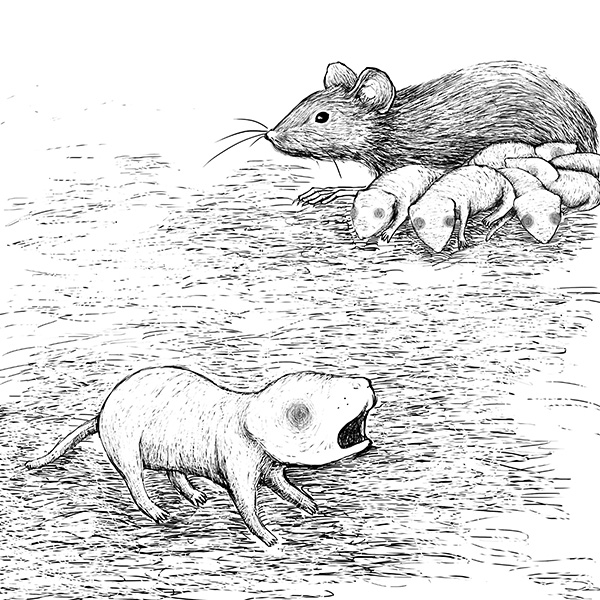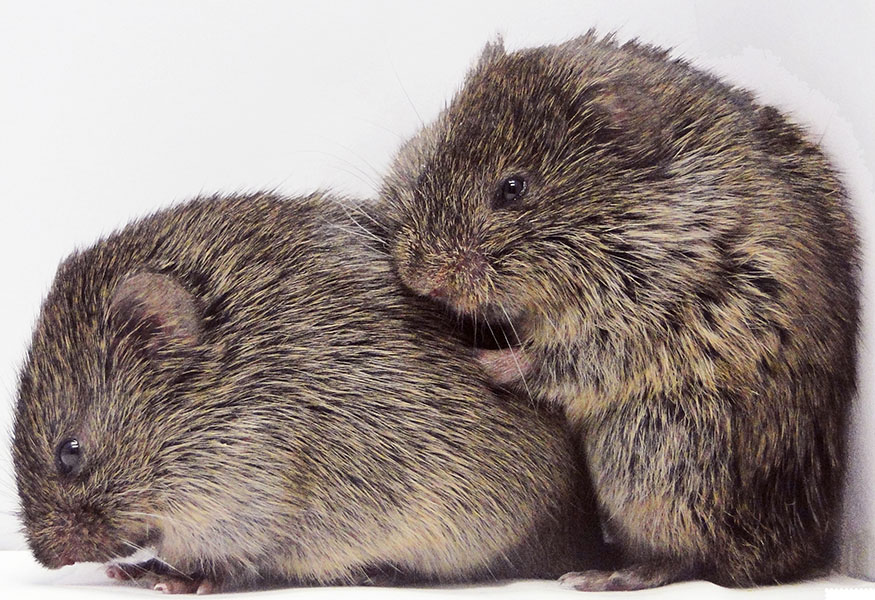Oxytocin’s effects aren’t just about love
At last, neuroscientists are learning how the hormone shapes social behaviors such as pair-bonding and parental care. It’s more complicated than they thought.
Support sound science and smart stories
Help us make scientific knowledge accessible to all
Donate today
When love is in the air, what’s happening in the brain? For many years, biologists would answer, “Oxytocin!” This small protein — just nine amino acids long — has sometimes been called “the love hormone” because it has been implicated in pair-bonding, maternal care and other positive, love-like social behaviors.
But lately, neuroscientists have been revising their thinking about oxytocin. Experiments with mice and other lab animals suggest that instead of acting as a trigger for pro-social behavior, the molecule may simply sharpen the perception of social cues, so that mice can learn to target their social behavior more accurately. “It turns out it’s not as simple and straightforward as ‘oxytocin equals love,’” says Gül Dölen, a neuroscientist at Johns Hopkins University. If something similar is true of humans, that may, among other things, add a fresh wrinkle in attempts to treat social disorders such as autism by tinkering with the oxytocin system.
Neuroscientists have long believed that the release of oxytocin in the brain could be triggered by social interactions with certain individuals such as offspring or mates that are important to a human or other animal. And when researchers experimentally block the action of oxytocin, mice lose the ability to recognize socially important individuals. This suggests that the molecule plays a central role in social learning — but researchers haven’t known exactly how oxytocin does its job.
That is changing, thanks to advances in neuroscience techniques, which in recent years have allowed researchers to identify and record the activity of individual oxytocin-producing neurons deep within the brain. And those recordings tell a story that differs from the old view — in subtle but important ways.
In the main smell center of rats’ brains, for example, measurements show that oxytocin inhibits the random, noisy firing of nerve cells, thus allowing the neural signals of actual odors to stand out more prominently. (It does this in a backhanded way, by exciting nerve cells known as granule cells, which inhibit other nerve cells.)
“There’s a lot of noise in the brain,” says Larry Young, a behavioral neuroscientist at Emory University who, with coauthor Robert Froemke, explores our new understanding of oxytocin in the 2021 Annual Review of Neuroscience. “But when oxytocin is released, it turns down the static so the signal comes in much more clearly.”

A mother mouse has to learn the sound of her offspring’s cries. Oxytocin silences some of the noise in her auditory system so that she can learn those cries more easily, researchers have found.
CREDIT: SHARI E. ROSS
That clarity is familiar to new parents, says Froemke, a neuroscientist at New York University Grossman School of Medicine and Young’s coauthor. “I’ve got two little kids,” he says. “Even two rooms away, air conditioner on, and I’m deep asleep, the baby starts crying and right away I’m awake and attending, full-pupil-dilated.”
Oxytocin also enhances the response of the brain’s reward system, says Yevgenia Kozorovitskiy, a neuroscientist at Northwestern University. This effect could shift the animal’s behavior away from seeking out new things in the environment, and toward focusing on social rewards.
In prairie voles, for example — which intrigue researchers for their monogamous behavior, rare in rodents — this shift facilitates pair-bonding. Among other effects, some of the oxytocin-sensitive cells link a mate’s odor to the reward system. “Pair-bonding is kind of like becoming addicted to a partner,” says Young. “The partner becomes inherently rewarding.” Promiscuous species such as mice and meadow voles lack those oxytocin receptors but, tantalizingly, they’re there in the brains of people, suggesting that we may respond more like prairie voles than mice. (Oxytocin’s molecular cousin, vasopressin, also plays a role in pair-bonding.)
The new understanding that oxytocin sharpens attention to socially salient signals may help to explain the common experience that love makes the world sparkle. “When you’re looking into the eyes of your partner, oxytocin could be making the world more vivid,” says Young.
There’s a further complication here, and an important one: If oxytocin’s real role is to clarify social-related sensory perceptions, not simply to promote sociality, then the chemical is likely to have different effects in different contexts. For example, Young notes, oxytocin enhances maternal care in mice — clearly a pro-social behavior — but it also increases maternal aggression toward unfamiliar individuals.

Prairie voles, unlike the vast majority of rodents, mate for life. Oxytocin-sensitive cells in their brain’s reward center contribute to good feelings in the presence of their partner.
CREDIT: COURTESY OF LARRY YOUNG
Moreover, female prairie voles respond differently to oxytocin depending on whether they have formed a pair bond yet, Young and his colleagues have found. In unbonded females, oxytocin reduces noise in the reward system, allowing them to learn to like a potential partner’s odor. In females that have already bonded with a partner, the molecule turns up the volume on the reward system to make the partner more rewarding, thus reducing aggression toward the partner.
Something similar may apply to people, too. In one study from 2012, 30 men who were in monogamous relationships maintained a slightly greater social distance from an attractive female stranger when they received an intranasal oxytocin spray than when they got a placebo. The effect wasn’t seen in a similar group of 27 single men.
The context-dependence of oxytocin may complicate efforts to use oxytocin to treat autism-spectrum disorder. Some therapists already use intranasal oxytocin sprays to treat people with autism, on the theory that it should enhance their response to social stimuli. However, a large clinical trial recently found no demonstrable effect.
That’s not surprising, Young says, because the trial did not control the context in which patients received the sprays. If a child is being bullied at school, for example, the proposed treatment might not help but instead might intensify that negative experience, he notes. Instead, Young thinks that any oxytocin-based therapies would need to be carefully delivered in the safety of a therapy session.
Neuroscientists also note that even though oxytocin clearly plays an important role in regulating social behaviors like pair-bonding and parental care, it’s not the only actor. “Falling in love is a full brain and body experience,” says Kozorovitskiy. “It has sensory elements and cognitive elements, and memory is important. Is oxytocin one of the many modulators that is mediating all those changes? Absolutely. But can we pin it all on oxytocin? That’s definitely an oversimplification.”
10.1146/knowable-021122-1
TAKE A DEEPER DIVE | Explore Related Scholarly Articles




